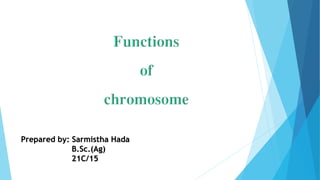
Presentation on Functions of Chromosomes
- 1. Prepared by: Sarmistha Hada B.Sc.(Ag) 21C/15
- 2. WHAT IS A CHROMOSOME The word ‘Chromosome’ is derived from two Greek words; Chroma meaning colour and Soma meaning body. Chromosomes are the rod shaped dark stained bodies as seen during metaphase stage of mitosis when the cells are stained with a suitable basic dye and viewed under a light microscope. Chromosomes were first described by Strausberger in 1875. The term ‘Chromosome’ was first used by Waldeyer in 1888. Chromosomes are clearly visible as distinct bodies during the stages of cell division only.
- 3. Although chromosomes were first described in 1875, their role in heredity was suggested independently by Sutton and Boveri in 1902 through their chromosomal theory of inheritance. It is now universally accepted that genes are located in chromosomes and responsible for transfer of genetic information. The various functions of chromosomes are explained below.
- 4. Chromosome Provides The Genetic Information It is universally accepted that DNA is the genetic material, and that in eukaryotes almost all the DNA is present in chromosomes. Thus the most important function of chromosomes is to provide the genetic information for various cellular functions essential for survival, growth, development, reproduction etc. of organisms. Chromosome contains the genes which are the basic unit of inheritance and help in transfer of genetic information from parents to offsprings.
- 5. Packaging of Genetic Material Each somatic cell of human contains DNA of about 174cm long if stretched end to end, but the nucleus of the cell which contains the DNA is only 6microns in diameter. The nucleus would not be able to accommodate such large amount of DNA without DNA packaging. All the DNA in human somatic cell is packaged compactly into 23 pairs of chromosomes with the help of histone and non histone proteins
- 7. Chromosome Protects The Genetic Material A very important function of chromosomes is to protect the genetic material (DNA) from being damaged during cell division. If all the DNA present in human somatic cells is fully extended, it would measure about 174 cm. A DNA molecule of such a length would be prone to breakage even under the most gentle situations prevailing in a cell. But in chromosomes, this DNA is not only packaged in 46 relatively very small and sturdy chromosomes, it is also complexed with histones and other proteins. which protect the DNA both from chemical (e.g., nuclease enzymes) and physical forces.
- 8. Distribution of DNA to Daughter Cells The properties of chromosomes ensure a precise distribution of DNA to the daughter nuclei during cell division. As a result, each of the two daughter nuclei produced through one mitotic division receives the same number of chromosomes as the parent nucleus. On the other hand, each of the four nuclei produced after one complete meiotic division gets only half the number of the chromosomes as the parent nucleus.
- 9. Regular and Directional Movement of the Genetic Material Chromosome movement is believed to occur mainly due to the shortening of spindle fibers. These fibers attach to the centromeric regions of chromosomes. Thus ensuring a regular and directional movement of the genetic material during cell division.
- 10. Regulation of Gene Action Gene action in eukaryotes is believed to be regulated through histone and non-histone proteins associated with chromosomes. Histone acetylation and deacetylation causes changes in transcription activity and thus regulates gene expression. Histone acetylation effectively removes the positive charge from the histone tail and reduces interaction between histone and nucleosome. This opens up the nucleosome and allows transcription mechinery to come in contact with the DNA template leading to gene transcription. Repression of gene transcription is achieved by the reverse of this mechanism.
- 11. Correct Replication of DNA Semiconservative replication of a linear DNA molecule inevitably leaves a short sequence at the two ends of this molecule in unreplicated state. This will lead to a progressive shortening of the molecule after every round of replication. Chromosome organization avoids this shortening as follows. The telomeres are made up of several copies of a short repeating sequence. The enzyme telomerase adds copies of this sequence at the chromosome ends. Therefore, the shortening that occurs due to replication is adequately compensated for by telomerase action, and the chromosome length is maintained.
- 12. Helps in Sex Determination Humans have 22 pairs of autosomes which determine the somatic characters and 1 pair of allosomes which are responsible for sex determination Human females contain 2 X chromosomes and produces only one type of gamete, i.e., X. the male on the other hand has 1 X and 1 Y chromosome, is heterogametic and produces two types of gametes X and Y. fusion of X sperm with ovum results in development of female sex and fusion of ovum with Y sperm results in male sex. This system of sex determination is found in Drosophila, human and some other mammals.
